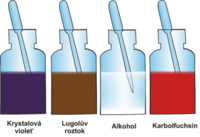Gram staining
One of the basic stains in microbiology, gram staining gave rise to the division of bacteria into Gram positive (G+) and Gram negative (G-). This division is based on the different structure of the bacterial wall.
Procedure[edit | edit source]
The sample or bacterial culture to be examined is applied to the slide and the staining solutions are gradually applied. Allow each solution to work for approximately 1 minute[1]. The procedure is easily remembered by the abbreviation VLAS (VLAK):
- Crystal Violet
- Lugol's solution
- Alcohol
- rinse with water
- Safranin or Carbolfuchsin
Positivity and negativity[edit | edit source]
G+[edit | edit source]
Gram-positive bacteria have a wall composed of peptidoglycan and polysaccharides through which teichoic acid passes. During staining, the crystalline violet enters the cells and forms a blue complex color with Lugol's solution. The alcohol is unable to penetrate the cell wall and dissolve the complex. Safranin staining gives the bacteria a deep purple color.
- G+ cocci: Staphylococcus, Streptococcus, Enterococcus;
- G+ bacilli: Corynebacterium, Clostridium, Listeria, Bacillus.
G–[edit | edit source]
Gram-negative bacteria have a wall consisting of a thin layer of peptidoglycan and a layer of lipopolysaccharide. In the same process, the third step involves washing out of the complex with alcohol and decolorization. Safranin stains the bacteria red.
- G- cocci: Neisseria;
- G- coccobacilli: Haemophilus influenzae, Bordetella pertussis, Legionella, Brucella, etc.
- G- bacilli: Klebsiella, E. coli, Enterobacter, Citrobacter, Serratia, Vibrio, Pseudomonas, Proteus, Helicobacter pylori, Yersinia, Campylobacter, Salmonella, Bacillus fragilis, etc.
G labile and non-staining[edit | edit source]
Some bacteria, especially after long cultivation and multiple passaging, or if they survive the attack of antibiotics against the cell wall (L-forms), can change from G+ to G-.
Bacteria that contain a lot of fatty acids and waxes in their wall (Mycobacterium tuberculosis) can not be stained by Gram at all.
Links[edit | edit source]
Related articles[edit | edit source]
Source[edit | edit source]
- RYŠKOVÁ, Olga. Návody k praktickým cvičením z lékařské mikrobiologie. 1. edition. Praha : Karolinum, 1997. ISBN 80-7184-307-5.
Reference[edit | edit source]
- ↑ JULÁK, Jaroslav. Praktická cvičení a semináře z lékařské mikrobiologie. 2. edition. Praha : Karolinum, 2009. 113 pp. ISBN 978-80-246-1141-9.



